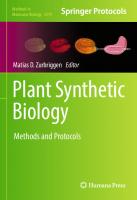Computational Methods in Synthetic Biology [2 ed.] 1071608215, 9781071608210
This second edition book provides complete coverage of the computational approaches currently used in Synthetic Biology.
297 31 8MB
English Pages 255 [254] Year 2020
Table of contents :
Preface
Contents
Contributors
Chapter 1: Using a Design of Experiments Approach to Inform the Design of Hybrid Synthetic Yeast Promoters
1 Introduction
2 Materials
3 Methods
3.1 Identifying Candidate Promoter Motifs
3.2 Defining Experimental Parameters
3.3 Screening the Promoter Design Space for Synthesis Constraint Violations and Incompatible Restriction Sites
3.4 Designing a Hybrid Promoter Library
3.5 Synthesis and Assembly of Designed Promoter Sequences
3.6 Suggestions for Future Work
4 Notes
References
Chapter 2: Computational Design of Multiplex Oligonucleotide-Based Assays
1 Introduction
2 Implementation
3 Databases
4 The Software Workflow
4.1 Data Preparation
4.2 Oligonucleotide Selection
4.3 Ligation Probe Design
4.4 Data Reduction Steps
4.5 Probe Specificity Check
4.6 Primer Package Creation
4.7 Primer Specificity Check
4.8 Primer Dimer Check
4.9 Output
References
Chapter 3: Computational Methods for the Design of Recombinase Logic Circuits
1 Introduction
2 Definition of the System Specification According to the Application
3 Definition of the Logic Function
4 Using CALIN or RECOMBINATOR to Obtain the Theoretical Biological Design
4.1 The CALIN Web-Interface: Multicellular Recombinase Logic
4.2 RECOMBINATOR: A Database of Single-Layer Recombinase Logic Device
5 Conclusion
Glossary
References
Chapter 4: Modular Modeling of Genetic Circuits in SBML Level 3
1 Introduction
2 Methods
2.1 The AND Gate Circuit
2.2 The comp Package and the libSBML Python API
2.3 Modeling the AND Gate with libSBML Python
2.3.1 TU_YES_A
2.3.2 pool_mRNA_YES_A
2.3.3 pool_Ra_A
2.3.4 TU_NOT_B, pool_mRNA_NOT_B, and pool_Ri_B
2.3.5 TU_YES_B
2.3.6 pool_siRNA_B
2.3.7 TU_AND
2.3.8 pool_mRNA_AND
2.3.9 pool_GFP
2.3.10 The Cell Model
2.4 Simulations and Results
3 Notes
References
Chapter 5: CRISPR-ERA: A Webserver for Guide RNA Design of Gene Editing and Regulation
1 Introduction
2 Methods
3 Procedures
3.1 CRISPR-ERA Input (Fig. 2)
3.2 CRISPR-ERA Output (Fig. 3)
3.3 Genome-Wide sgRNA Library Building Pipeline
4 Conclusion
References
Chapter 6: iGUIDE Method for CRISPR Off-Target Detection
1 Introduction
2 Materials
3 Methods
3.1 Primary Processing
3.2 Secondary Processing
3.3 Tertiary Processing
3.4 Reporting
4 Notes
References
Chapter 7: Web-Based Base Editing Toolkits: BE-Designer and BE-Analyzer
1 Introduction
2 Software
3 Methods
3.1 BE-Designer
3.2 BE-Analyzer
4 Notes
References
Chapter 8: Synthetic Gene Circuit Analysis and Optimization
1 Introduction
2 Methods
2.1 Analysis of Synthetic Gene Circuits
2.1.1 Optimization Framework and General Procedure
2.1.2 Detection of Bistability in Biomolecular Circuits
2.2 Design of Synthetic Gene Circuits
2.2.1 Optimization Framework and General Procedure
2.2.2 Design of Synthetic Bistable Switches Starting from a Library of Parts
3 Results
3.1 Detection of Bistability in Biomolecular Circuits
3.2 Design of Synthetic Bistable Switches Starting from a Library of Parts
4 Implementation Notes
4.1 Bistable Switch Detection
4.2 Bistable Switch Design
References
Chapter 9: Monitoring Single S. cerevisiae Cells with Multifrequency Electrical Impedance Spectroscopy in an Electrode-Integra...
1 Introduction
2 Materials
2.1 Materials for Device Fabrication and Experiments
2.2 Software
3 Methods
3.1 Device Fabrication
3.2 Experimental Setup
3.3 Trap Single S. cerevisiae Cells
3.4 Electrical Impedance Measurements
3.5 Distinguish the Number of S. cerevisiae Cells at Each Trapping Site
3.6 Classify Cell Growth States of S. cerevisiae Cells
3.6.1 Experimental Procedure
3.6.2 Data Analysis
3.7 Monitor Cell Growth/Motion
3.7.1 Experimental Procedure
3.7.2 Data Analysis
4 Notes
References
Chapter 10: Construction of Protein Expression Network
1 Introduction
2 Materials
2.1 Source of the Expression Data
2.2 Data Processing
2.3 Biological Data Annotation
2.4 Construction and Analysis of a Protein Network
3 Methods
3.1 Identification of Expression Datasets
3.2 Data Processing
3.3 Biological Data Annotation
3.4 Construction of PPI Network
3.5 Network Visualization
3.6 Network Analysis
4 Notes
References
Chapter 11: Systems-Theoretic Approaches to Design Biological Networks with Desired Functionalities
1 Introduction
2 Useful Systems Theory Concepts
2.1 Linearization
2.2 Stability
2.3 Characterizing Parameters in Linear Time-Invariant (LTI) System Framework
3 Methodology and Application
3.1 Generalized Algorithm for Finding Design Principles
3.2 Translation of Perfect Adaptation to Systems Theory Requirements
3.3 Adaptation in Biological Networks
3.3.1 Response to Staircase Input
3.4 Finding Optimal Set/s of Parameters
3.4.1 Imperfect Adaptation
3.4.2 Equations
4 Conclusions
References
Chapter 12: A Deterministic Compartmental Modeling Framework for Disease Transmission
1 Introduction
2 Preliminary Concepts
2.1 Incidence and Prevalence
2.2 Equilibrium Points
2.3 Basic Reproduction Number
2.4 Stability of Equilibrium Points
2.5 Theorem for the Analysis of Stability
3 Methodology
3.1 Model Fitting and Estimation of Unknown Parameters
3.2 Stability Analysis
4 Case Study on Tuberculosis
References
Chapter 13: Computer Aided Assembly and Verification of Synthetic Chromosomes
1 Introduction
1.1 Workflows for Synthetic Genome Assembly and Verification
2 Materials
3 Methods
3.1 Synthetic Genome Assembly Workflows
3.1.1 Sequence Assembly Annotation of the S. cerevisiae Gcn1p Region
3.1.2 Sequence Decomposition for Type-2S Assembly
3.2 Synthetic Genome Verification
3.2.1 Install Required Software and Download Sequencing Data
3.2.2 Aligning Short-Reads to the Reference Genome
3.2.3 Variant Calling from Short-Reads Alignment
References
Chapter 14: Minimal Genome Design Algorithms Using Whole-Cell Models
1 Introduction
2 Materials
2.1 Code Availability
2.2 Model Availability
2.3 Equipment
2.4 Simulation Process
2.5 Data Format
2.6 Data Analysis Process
3 Methods
3.1 Install M. genitalium Whole-Cell Model on Supercomputer
3.2 Minesweeper Algorithm
3.2.1 Steps to Install Minesweeper
3.2.2 First Stage
3.2.3 Second Stage
3.2.4 Third Stage
3.2.5 Fourth Stage
3.3 GAMA Algorithm
3.3.1 Steps to Install GAMA
3.3.2 First Stage
3.3.3 Second Stage
3.3.4 Third Stage
References
Chapter 15: Tn-Core: Functionally Interpreting Transposon-Sequencing Data with Metabolic Network Analysis
1 Introduction
2 Software and Inputs
2.1 The Stand-Alone Version of Tn-Core
2.1.1 Software
2.1.2 Input Data
2.1.3 Additional Requirements Specific to the Automated Pipeline
2.2 Requirements for the Tn-Core Web Application
3 Methods and Outputs
3.1 Contextualizing Tn-Seq Data (Local Version)
3.1.1 Prepare the Workspace
3.1.2 Prepare the Input Data
3.1.3 Run Tn-Core
3.2 Contextualizing Tn-Seq Data (Local Version: Automated)
3.2.1 Prepare the Workspace
3.2.2 Run Tn-Core
3.3 Contextualizing Tn-Seq Data (Web Application)
3.3.1 Run Tn-Core
3.3.2 Obtain the Output Files
3.4 Contextualizing Tn-Seq Data: Output Files
3.5 Refining a GENRE (Local Version)
3.5.1 Prepare the Workspace
3.5.2 Prepare the Input Data
3.5.3 Run Tn-Core
4 Notes
References
Chapter 16: Genome-Scale Metabolic Modeling of Escherichia coli and Its Chassis Design for Synthetic Biology Applications
1 Introduction
1.1 Constructions of Escherichia coli Genome-Scale Metabolic Models´ Workflow
2 Materials
2.1 Automated Reconstruction of Metabolic Models (AuReMe) Published in 2018
2.2 CarveMe Published in 2018
2.3 MetaDraft Published in 2018
2.4 RAVEN Version 2.0 Published in 2018
2.5 ModelSEED Version 2.2
2.6 Merlin Version 3.8 (2018)
2.7 KBase Published in 2018
3 Escherichia coli Chassis Design for Synthetic Biology Applications
4 Synthetic Production of 1,4-Butanediol from Engineered Escherichia coli K12 as a Case Study
5 Summary
References
Chapter 17: A Systems Bioinformatics Approach to Interconnect Biological Pathways
1 Introduction
2 Overview
2.1 Handling Input Diversity
2.2 Enrichment Analysis Workflow
2.3 The Missing Pathway Approach: Identifying and Adding the Missing Network Pathway Nodes
2.4 Handling Large Complementary Pathway-to-Pathway Networks
2.5 Exporting Network Metrics
3 Statistical Significance
4 Discussion and Novelty
References
Index
Preface
Contents
Contributors
Chapter 1: Using a Design of Experiments Approach to Inform the Design of Hybrid Synthetic Yeast Promoters
1 Introduction
2 Materials
3 Methods
3.1 Identifying Candidate Promoter Motifs
3.2 Defining Experimental Parameters
3.3 Screening the Promoter Design Space for Synthesis Constraint Violations and Incompatible Restriction Sites
3.4 Designing a Hybrid Promoter Library
3.5 Synthesis and Assembly of Designed Promoter Sequences
3.6 Suggestions for Future Work
4 Notes
References
Chapter 2: Computational Design of Multiplex Oligonucleotide-Based Assays
1 Introduction
2 Implementation
3 Databases
4 The Software Workflow
4.1 Data Preparation
4.2 Oligonucleotide Selection
4.3 Ligation Probe Design
4.4 Data Reduction Steps
4.5 Probe Specificity Check
4.6 Primer Package Creation
4.7 Primer Specificity Check
4.8 Primer Dimer Check
4.9 Output
References
Chapter 3: Computational Methods for the Design of Recombinase Logic Circuits
1 Introduction
2 Definition of the System Specification According to the Application
3 Definition of the Logic Function
4 Using CALIN or RECOMBINATOR to Obtain the Theoretical Biological Design
4.1 The CALIN Web-Interface: Multicellular Recombinase Logic
4.2 RECOMBINATOR: A Database of Single-Layer Recombinase Logic Device
5 Conclusion
Glossary
References
Chapter 4: Modular Modeling of Genetic Circuits in SBML Level 3
1 Introduction
2 Methods
2.1 The AND Gate Circuit
2.2 The comp Package and the libSBML Python API
2.3 Modeling the AND Gate with libSBML Python
2.3.1 TU_YES_A
2.3.2 pool_mRNA_YES_A
2.3.3 pool_Ra_A
2.3.4 TU_NOT_B, pool_mRNA_NOT_B, and pool_Ri_B
2.3.5 TU_YES_B
2.3.6 pool_siRNA_B
2.3.7 TU_AND
2.3.8 pool_mRNA_AND
2.3.9 pool_GFP
2.3.10 The Cell Model
2.4 Simulations and Results
3 Notes
References
Chapter 5: CRISPR-ERA: A Webserver for Guide RNA Design of Gene Editing and Regulation
1 Introduction
2 Methods
3 Procedures
3.1 CRISPR-ERA Input (Fig. 2)
3.2 CRISPR-ERA Output (Fig. 3)
3.3 Genome-Wide sgRNA Library Building Pipeline
4 Conclusion
References
Chapter 6: iGUIDE Method for CRISPR Off-Target Detection
1 Introduction
2 Materials
3 Methods
3.1 Primary Processing
3.2 Secondary Processing
3.3 Tertiary Processing
3.4 Reporting
4 Notes
References
Chapter 7: Web-Based Base Editing Toolkits: BE-Designer and BE-Analyzer
1 Introduction
2 Software
3 Methods
3.1 BE-Designer
3.2 BE-Analyzer
4 Notes
References
Chapter 8: Synthetic Gene Circuit Analysis and Optimization
1 Introduction
2 Methods
2.1 Analysis of Synthetic Gene Circuits
2.1.1 Optimization Framework and General Procedure
2.1.2 Detection of Bistability in Biomolecular Circuits
2.2 Design of Synthetic Gene Circuits
2.2.1 Optimization Framework and General Procedure
2.2.2 Design of Synthetic Bistable Switches Starting from a Library of Parts
3 Results
3.1 Detection of Bistability in Biomolecular Circuits
3.2 Design of Synthetic Bistable Switches Starting from a Library of Parts
4 Implementation Notes
4.1 Bistable Switch Detection
4.2 Bistable Switch Design
References
Chapter 9: Monitoring Single S. cerevisiae Cells with Multifrequency Electrical Impedance Spectroscopy in an Electrode-Integra...
1 Introduction
2 Materials
2.1 Materials for Device Fabrication and Experiments
2.2 Software
3 Methods
3.1 Device Fabrication
3.2 Experimental Setup
3.3 Trap Single S. cerevisiae Cells
3.4 Electrical Impedance Measurements
3.5 Distinguish the Number of S. cerevisiae Cells at Each Trapping Site
3.6 Classify Cell Growth States of S. cerevisiae Cells
3.6.1 Experimental Procedure
3.6.2 Data Analysis
3.7 Monitor Cell Growth/Motion
3.7.1 Experimental Procedure
3.7.2 Data Analysis
4 Notes
References
Chapter 10: Construction of Protein Expression Network
1 Introduction
2 Materials
2.1 Source of the Expression Data
2.2 Data Processing
2.3 Biological Data Annotation
2.4 Construction and Analysis of a Protein Network
3 Methods
3.1 Identification of Expression Datasets
3.2 Data Processing
3.3 Biological Data Annotation
3.4 Construction of PPI Network
3.5 Network Visualization
3.6 Network Analysis
4 Notes
References
Chapter 11: Systems-Theoretic Approaches to Design Biological Networks with Desired Functionalities
1 Introduction
2 Useful Systems Theory Concepts
2.1 Linearization
2.2 Stability
2.3 Characterizing Parameters in Linear Time-Invariant (LTI) System Framework
3 Methodology and Application
3.1 Generalized Algorithm for Finding Design Principles
3.2 Translation of Perfect Adaptation to Systems Theory Requirements
3.3 Adaptation in Biological Networks
3.3.1 Response to Staircase Input
3.4 Finding Optimal Set/s of Parameters
3.4.1 Imperfect Adaptation
3.4.2 Equations
4 Conclusions
References
Chapter 12: A Deterministic Compartmental Modeling Framework for Disease Transmission
1 Introduction
2 Preliminary Concepts
2.1 Incidence and Prevalence
2.2 Equilibrium Points
2.3 Basic Reproduction Number
2.4 Stability of Equilibrium Points
2.5 Theorem for the Analysis of Stability
3 Methodology
3.1 Model Fitting and Estimation of Unknown Parameters
3.2 Stability Analysis
4 Case Study on Tuberculosis
References
Chapter 13: Computer Aided Assembly and Verification of Synthetic Chromosomes
1 Introduction
1.1 Workflows for Synthetic Genome Assembly and Verification
2 Materials
3 Methods
3.1 Synthetic Genome Assembly Workflows
3.1.1 Sequence Assembly Annotation of the S. cerevisiae Gcn1p Region
3.1.2 Sequence Decomposition for Type-2S Assembly
3.2 Synthetic Genome Verification
3.2.1 Install Required Software and Download Sequencing Data
3.2.2 Aligning Short-Reads to the Reference Genome
3.2.3 Variant Calling from Short-Reads Alignment
References
Chapter 14: Minimal Genome Design Algorithms Using Whole-Cell Models
1 Introduction
2 Materials
2.1 Code Availability
2.2 Model Availability
2.3 Equipment
2.4 Simulation Process
2.5 Data Format
2.6 Data Analysis Process
3 Methods
3.1 Install M. genitalium Whole-Cell Model on Supercomputer
3.2 Minesweeper Algorithm
3.2.1 Steps to Install Minesweeper
3.2.2 First Stage
3.2.3 Second Stage
3.2.4 Third Stage
3.2.5 Fourth Stage
3.3 GAMA Algorithm
3.3.1 Steps to Install GAMA
3.3.2 First Stage
3.3.3 Second Stage
3.3.4 Third Stage
References
Chapter 15: Tn-Core: Functionally Interpreting Transposon-Sequencing Data with Metabolic Network Analysis
1 Introduction
2 Software and Inputs
2.1 The Stand-Alone Version of Tn-Core
2.1.1 Software
2.1.2 Input Data
2.1.3 Additional Requirements Specific to the Automated Pipeline
2.2 Requirements for the Tn-Core Web Application
3 Methods and Outputs
3.1 Contextualizing Tn-Seq Data (Local Version)
3.1.1 Prepare the Workspace
3.1.2 Prepare the Input Data
3.1.3 Run Tn-Core
3.2 Contextualizing Tn-Seq Data (Local Version: Automated)
3.2.1 Prepare the Workspace
3.2.2 Run Tn-Core
3.3 Contextualizing Tn-Seq Data (Web Application)
3.3.1 Run Tn-Core
3.3.2 Obtain the Output Files
3.4 Contextualizing Tn-Seq Data: Output Files
3.5 Refining a GENRE (Local Version)
3.5.1 Prepare the Workspace
3.5.2 Prepare the Input Data
3.5.3 Run Tn-Core
4 Notes
References
Chapter 16: Genome-Scale Metabolic Modeling of Escherichia coli and Its Chassis Design for Synthetic Biology Applications
1 Introduction
1.1 Constructions of Escherichia coli Genome-Scale Metabolic Models´ Workflow
2 Materials
2.1 Automated Reconstruction of Metabolic Models (AuReMe) Published in 2018
2.2 CarveMe Published in 2018
2.3 MetaDraft Published in 2018
2.4 RAVEN Version 2.0 Published in 2018
2.5 ModelSEED Version 2.2
2.6 Merlin Version 3.8 (2018)
2.7 KBase Published in 2018
3 Escherichia coli Chassis Design for Synthetic Biology Applications
4 Synthetic Production of 1,4-Butanediol from Engineered Escherichia coli K12 as a Case Study
5 Summary
References
Chapter 17: A Systems Bioinformatics Approach to Interconnect Biological Pathways
1 Introduction
2 Overview
2.1 Handling Input Diversity
2.2 Enrichment Analysis Workflow
2.3 The Missing Pathway Approach: Identifying and Adding the Missing Network Pathway Nodes
2.4 Handling Large Complementary Pathway-to-Pathway Networks
2.5 Exporting Network Metrics
3 Statistical Significance
4 Discussion and Novelty
References
Index
![Computational Methods in Synthetic Biology [2 ed.]
1071608215, 9781071608210](https://ebin.pub/img/200x200/computational-methods-in-synthetic-biology-2nbsped-1071608215-9781071608210.jpg)
- Author / Uploaded
- Mario Andrea Marchisio
![Computational Methods in Synthetic Biology [2nd ed.]
9781071608210, 9781071608227](https://ebin.pub/img/200x200/computational-methods-in-synthetic-biology-2nd-ed-9781071608210-9781071608227.jpg)
![Computational Methods in Synthetic Biology [1 ed.]
149391877X, 9781493918775](https://ebin.pub/img/200x200/computational-methods-in-synthetic-biology-1nbsped-149391877x-9781493918775.jpg)







